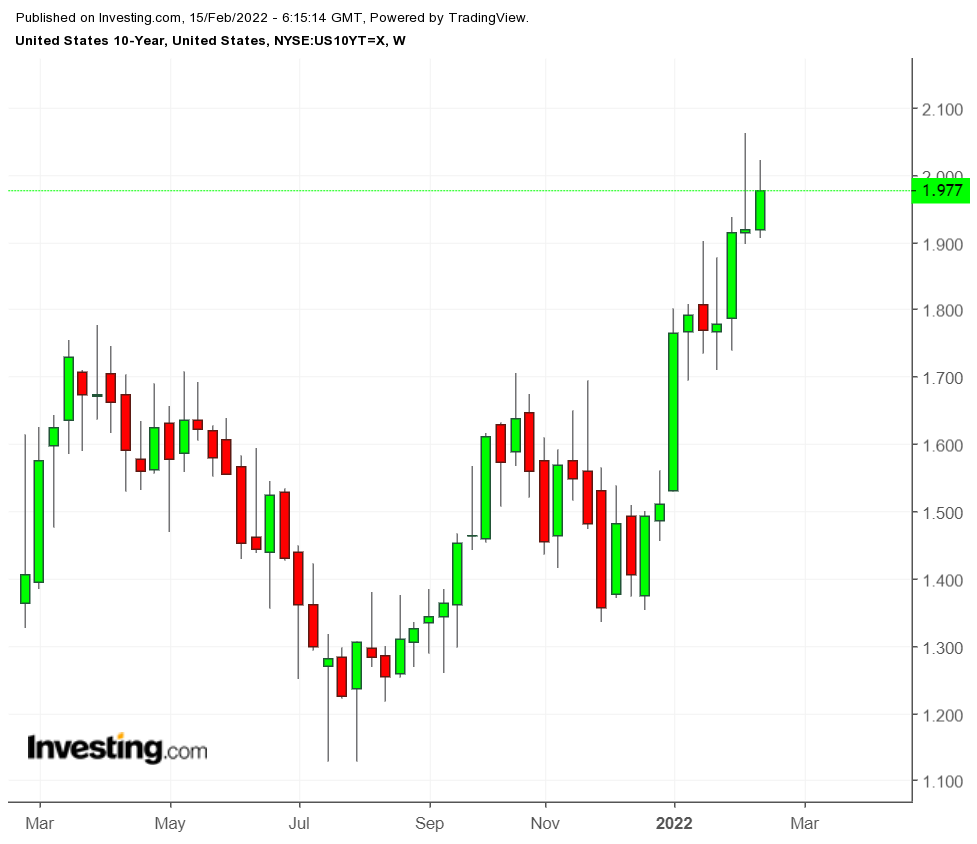Investors in US Treasuries are being squeezed between the rock of Russia’s threat to Ukraine and the hard place of surging inflation.

The consumer price index for January registered a 7.5% increase on the year Thursday, sending yields on the benchmark 10-year Treasury note briefly above 2%. Yields fell back again on Friday as the US warned Russia could invade its neighbor as soon as this week.
On Monday, the 10-year yield rose again, very near to 2% after Russian Foreign Minister Sergei Lavrov urged President Vladimir Putin to keep trying a diplomatic approach to allay what Putin claims are his security concerns. At time of writing, the benchmark's yield is once again back above 2%.
Meanwhile, hawkish talk on Friday and Monday from St. Louis Federal Reserve Bank President James Bullard pushed up yields on the 2-year Treasury note to 1.6%, triple their level of just over 0.5% three months ago. These short-term notes are considered more sensitive to Fed changes in the overnight federal funds rate.

All this has led to the much-dreaded flattening of the yield curve—dreaded because it often signals a slowdown in the economy, and even a recession, when short-dated Treasuries start to yield more than long-dated in what is known as an inversion.
Fed policymakers have been tamping down expectations of a half-point increase in the fed funds rate in March, despite Bullard’s hawkish stance. The inflation reading for February, which comes ahead of the meeting of the Federal Open Market Committee, could influence the Fed’s decision, though most economists expect year-on-year inflation to remain high in any case.
Bond investors will also be scrutinizing the minutes of the Fed’s January meeting, which will be released on Wednesday, for clues about the runoff of the Fed’s bond portfolio. Some analysts are suggesting the Fed could forestall an inversion in bond yields by selling off longer-dated bonds, depressing the price, and boosting the yield.
The conflicting goals for bond investors—sell ahead of rate increases, buy into safe havens amid geopolitical tensions—may actually make it easier for the Fed to maneuver a soft landing for the US economy, some are speculating. The tug of war makes for volatile trading, but one motivation can offset the other as investors shift their priorities.
Many can’t shake the nagging suspicion that the Fed missed the boat on inflation and should have acted sooner. At the same time, they don’t want policymakers to compound that mistake by overreacting now with measures that could sabotage the economy. This, too, adds to bond market volatility.
In Europe, the selloff in government bonds abated at the prospect of war on NATO’s doorstep. Yields on benchmark 10-year sovereign bonds fell nearly 10 basis points in some instances.

Germany’s 10-year bond yield, for instance, fell to 0.21% at one point on Monday after topping 0.30% on Friday. However, yields resumed rising as the day progressed.
Policymakers at the European Central Bank also made the case that inflation in Europe is different than in the US and does not require the same monetary policy action. Ukraine tensions made it a lot easier for investors to accept this point of view.
